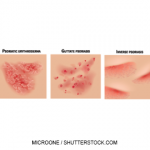 Mirikizumab is a humanized, IgG4, monoclonal antibody that binds to the p19 subunit of IL-23. It’s currently in clinical trials to manage immune mediated diseases, such as Crohn’s disease, ulcerative colitis and psoriasis. The randomized, phase 2 OASIS-2 trial (N=1,465, NCT03535194) compared the safety and efficacy of subcutaneous mirikizumab with subcutaneous secukinumab and placebo in adults with moderate to severe plaque psoriasis.1
Mirikizumab is a humanized, IgG4, monoclonal antibody that binds to the p19 subunit of IL-23. It’s currently in clinical trials to manage immune mediated diseases, such as Crohn’s disease, ulcerative colitis and psoriasis. The randomized, phase 2 OASIS-2 trial (N=1,465, NCT03535194) compared the safety and efficacy of subcutaneous mirikizumab with subcutaneous secukinumab and placebo in adults with moderate to severe plaque psoriasis.1
Endpoints for this multicenter, doubleblind, placebo-controlled study included the proportion of patients with a Static Physician’s Global Assessment (sPGA) of 0 or 1 who achieved at least a two-point improve ment and the proportion of patients who achieved at least a 90% improvement from baseline in the Psoriasis Area and Severity Index (PASI 90), compared with placebo, at week 16. Evaluated secondary endpoints at week 16 included the proportion of patients who achieved at least a 75–100% improvement from baseline in the PASI 75/100.
Patients were randomized in a 4:4:4:1 ratio to receive:
- 250 mg of mirikizumab at weeks 0, 4, 8 and 12, followed by 250 mg of mirikizumab every eight weeks starting at week 16;
- 250 mg of mirikizumab at weeks 0, 4, 8 and 12, followed by 125 mg of mirikizumab every eight weeks starting at week 16;
- 300 mg of secukinumab at weeks 0, 1, 2, 3 and 4, followed by 300 mg secukinumab every four weeks starting at week 4; or
- Placebo at weeks 0, 4, 8 and 12, followed by 250 mg of mirakizumab every four weeks starting at week 16 through 32, followed by mirikizumab every eight weeks thereafter.
Patients were followed for 52 weeks.
Results: Mirikizumab met all the primary endpoints and all the key secondary endpoints at week 16, showing superiority to placebo. It also demonstrated non-inferiority to secukinumab in key secondary endpoints at week 16 and demonstrated superiority in key secondary endpoints at week 52.
The most common adverse event in mirikizumab-treated patients was nasopharyngitis, occurring in at least 5% of patients up to week 16. During the combined induction and maintenance treatment periods (up to week 52), the most common adverse reactions were arthralgias, back pain, headache, nasopharyngitis and upper respiratory infections. The frequency of serious adverse events was comparable across all treatments.
Michele B. Kaufman, PharmD, BCGP, is a freelance medical writer based in New York City and a pharmacist at New York Presbyterian Lower Manhattan Hospital.
Reference
- Eli Lilly and Co. News release: Lilly’s mirikizumab superior to Cosentyx (secukinumab) in a phase 3 study for patients with moderate to severe plaque psoriasis. 2020 Jul 17.


